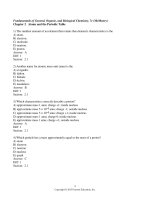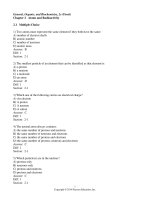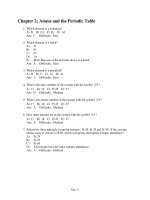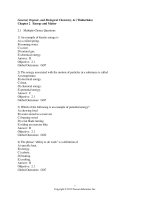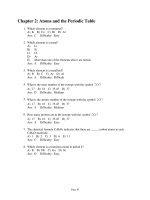General organic and biological chemistry structures of life 4th edition timberlake test bank
Bạn đang xem bản rút gọn của tài liệu. Xem và tải ngay bản đầy đủ của tài liệu tại đây (54.27 KB, 20 trang )
General, Organic, and Biological Chemistry, 4e (Timberlake)
Chapter 2 Energy and Matter
2.1 Multiple-Choice Questions
1) An example of kinetic energy is
A) a coiled spring.
B) running water.
C) a tree.
D) natural gas.
E) chemical energy.
Answer: B
Objective: 2.1
Global Outcomes: GO7
2) The energy associated with the motion of particles in a substance is called
A) temperature.
B) electrical energy.
C) heat.
D) chemical energy.
E) potential energy.
Answer: C
Objective: 2.1
Global Outcomes: GO7
3) Which of the following is an example of potential energy?
A) chewing food
B) water stored in a reservoir
C) burning wood
D) a fan blade turning
E) riding an exercise bike
Answer: B
Objective: 2.1
Global Outcomes: GO2
4) The phrase "ability to do work" is a definition of
A) specific heat.
B) energy.
C) calorie.
D) heating.
E) cooling.
Answer: B
Objective: 2.1
Global Outcomes: GO7
1
Copyright © 2013 Pearson Education, Inc.
5) The energy stored in the chemical bonds of a carbohydrate molecule is
A) specific heat.
B) kinetic energy.
C) potential energy.
D) work.
E) a calorie.
Answer: C
Objective: 2.1
Global Outcomes: GO2
6) The energy of motion is referred to as
A) work.
B) freezing.
C) specific heat.
D) potential energy.
E) kinetic energy.
Answer: E
Objective: 2.1
7) In which of the following would the particles move most rapidly?
A) ice at -20 °C
B) water at 20 °C
C) steam at 110 °C
D) boiling water
E) ice at 0 °C
Answer: C
Objective: 2.1
Global Outcomes: GO2
8) 650. J is the same amount of energy as
A) 155 cal
B) 2720 cal
C) 650 cal
D) 1550 cal
E) 2.72 cal
Answer: A
Objective: 2.1
Global Outcomes: GO4
2
Copyright © 2013 Pearson Education, Inc.
9) 3.25 kcal is the same amount of energy as
A) 3.25 J
B) 0.777 J
C) 777 J
D) 13600 J
E) 13.6 J
Answer: D
Objective: 2.1
Global Outcomes: GO4
10) Global warming is believed to result from all of the following except
A) burning of fossil fuels.
B) increasing levels of carbon dioxide in the atmosphere.
C) deforestation.
D) movement of the Earth closer to the Sun.
E) carbon dioxide trapping the heat produced by the Sun.
Answer: D
Objective: 2.2
Global Outcomes: GO9
11) A temperature of 41 °F is the same as
A) 5 °C.
B) 310 °C.
C) -9 °C.
D) 16 °C.
E) 42 °C.
Answer: A
Objective: 2.2
Global Outcomes: GO4
12) If the temperature is 20 °C, what is the corresponding temperature on the Fahrenheit scale?
A) -22 °F
B) 68 °F
C) 43 °F
D) 239 °F
E) 94 °F
Answer: B
Objective: 2.2
Global Outcomes: GO4
3
Copyright © 2013 Pearson Education, Inc.
13) If the temperature is - 55 °C, what is the corresponding temperature on the Kelvin scale?
A) 225 K
B) 218 K
C) 55 K
D) 273 K
E) 328 K
Answer: B
Objective: 2.2
Global Outcomes: GO4
14) A patient has a temperature of 38.5 °C. What is the temperature in degrees Fahrenheit?
A) 70.5 °F
B) 311 °F
C) 126.9 °F
D) 101.3 °F
E) 11.7 °F
Answer: D
Objective: 2.2
Global Outcomes: GO4
15) The temperature of liquid nitrogen is - 196 °C. What is the corresponding reading on the
Kelvin scale?
A) 77 K
B) -127 K
C) -91 K
D) 48 K
E) 146 K
Answer: A
Objective: 2.2
Global Outcomes: GO4
16) On a hot day, the thermometer read 95 °F. What is the temperature in degrees Celsius?
A) 77 °C
B) 113 °C
C) 35 °C
D) 63 °C
E) 178 °C
Answer: C
Objective: 2.2
Global Outcomes: GO4
4
Copyright © 2013 Pearson Education, Inc.
17) Absolute zero is
A) the freezing point of water using the Celsius scale.
B) the boiling point of liquid nitrogen.
C) the temperature on the Kelvin scale corresponding to 32 °F.
D) the coldest temperature possible.
E) the freezing point of liquid nitrogen.
Answer: D
Objective: 2.2
Global Outcomes: GO7
18) Helium is a(n)
A) compound.
B) heterogeneous mixture.
C) element.
D) homogeneous mixture.
E) electron.
Answer: C
Objective: 2.3
Global Outcomes: GO2
19) Air is a(n)
A) compound.
B) heterogeneous mixture.
C) element.
D) homogeneous mixture.
E) None of the above.
Answer: D
Objective: 2.3
Global Outcomes: GO7
20) Coins in a piggy bank is a(n)
A) compound.
B) heterogeneous mixture.
C) element.
D) homogeneous mixture.
E) None of the above.
Answer: B
Objective: 2.3
Global Outcomes: GO2
5
Copyright © 2013 Pearson Education, Inc.
21) Gold in a wedding ring is a(n)
A) compound.
B) heterogeneous mixture.
C) element.
D) homogeneous mixture.
E) None of the above.
Answer: C
Objective: 2.3
Global Outcomes: GO2
22) The primary substances of which all other things are composed are
A) molecules.
B) compounds.
C) elements.
D) electrons.
E) protons.
Answer: C
Objective: 2.3
Global Outcomes: GO2
23) Which of the following is a property of a solid?
A) It takes the shape of the container.
B) It fills the volume of the container.
C) The particles move at a rapid rate.
D) The interactions between its particles are very weak.
E) The particles have fixed positions and are very close together.
Answer: E
Objective: 2.4
Global Outcomes: GO2
24) Which of the following is a physical property of both liquids and gases?
A) has its own shape
B) has a definite volume
C) has strong interactions between its particles
D) has randomly arranged particles
E) has large spaces between molecules
Answer: D
Objective: 2.4
Global Outcomes: GO2
6
Copyright © 2013 Pearson Education, Inc.
25) Which one of the following properties describes a liquid?
A) has its own shape
B) particles are close together and move randomly
C) particles move very rapidly
D) fills the entire volume of the container
E) There is essentially no interaction between the particles.
Answer: B
Objective: 2.4
Global Outcomes: GO2
26) The physical state(s) present when a substance is melting is (are)
A) solid.
B) liquid.
C) gas.
D) solid + liquid.
E) liquid + gas.
Answer: D
Objective: 2.4
Global Outcomes: GO2
27) The formation of a gas resulting from the escape of high-energy particles from the surface of
a liquid is known as
A) evaporation.
B) deposition.
C) boiling.
D) melting.
E) sublimation.
Answer: A
Objective: 2.4
Global Outcomes: GO2
28) When a solid is converted directly to a gas, the change of state is called
A) freezing.
B) melting.
C) boiling.
D) condensation.
E) sublimation.
Answer: E
Objective: 2.4
Global Outcomes: GO7
7
Copyright © 2013 Pearson Education, Inc.
29) In a gas, the distance between the particles is
A) very close relative to the size of the molecules.
B) close relative to the size of the molecules.
C) fixed relative to the size of the molecules.
D) small relative to the size of the molecules.
E) very large relative to the size of the molecules.
Answer: E
Objective: 2.4
Global Outcomes: GO2
30) Which of the following does NOT involve a change of state?
A) melting ice
B) freezing water
C) vaporization of alcohol
D) sublimation of dry ice
E) pouring water into a vacuum-insulated bottle
Answer: E
Objective: 2.4
Global Outcomes: GO2
31) A heating curve illustrates
A) what a substance looks like as it is heated.
B) what happens to the particles of a substance as it is heated.
C) what happens to the heat applied as the temperature is increased.
D) the changes in the temperature and physical state of a substance as it is heated.
E) the chemical changes that occur as the substance is heated.
Answer: D
Objective: 2.4
Global Outcomes: GO9
32) Which of the following does NOT represent a step on the heating curve of water?
A) The temperature of steam cannot exceed 100 °C.
B) The temperature of ice remains at 0 °C as it melts.
C) The temperature of liquid water increases linearly as it is heated.
D) The temperature of liquid water remains at 100 °C as it boils.
E) Both liquid water and ice are present at 0 °C.
Answer: A
Objective: 2.4
Global Outcomes: GO9
8
Copyright © 2013 Pearson Education, Inc.
33) Which of the following is an example of a physical change?
A) grinding coffee beans
B) baking a cake
C) converting water to hydrogen and oxygen
D) digesting a cheeseburger
E) burning coal
Answer: A
Objective: 2.4
Global Outcomes: GO2
34) Which of the following would NOT be a physical change?
A) freezing water to make ice cubes
B) tearing a piece of aluminum foil
C) boiling water for soup
D) burning gasoline in a lawnmower
E) melting gold to make jewelry
Answer: D
Objective: 2.4
Global Outcomes: GO2
35) Which of the following is a chemical change?
A) cutting a rope
B) bending a steel rod
C) making a snowman
D) burning sugar
E) melting gold
Answer: D
Objective: 2.4
Global Outcomes: GO2
36) Which of the following is a physical change?
A) baking a cake
B) dry ice subliming
C) fermenting grapes to produce wine
D) digesting a meal
E) a tomato ripening
Answer: B
Objective: 2.4
Global Outcomes: GO2
9
Copyright © 2013 Pearson Education, Inc.
37) The specific heat of a substance is the amount of heat needed to
A) change 1 g of the substance from the solid to the liquid state.
B) raise the temperature of 1 g of the substance by 1 °C.
C) change 1 g of the substance from the liquid to the solid state.
D) convert 1 g of a liquid to gas.
E) convert 1 g of a solid to a gas.
Answer: B
Objective: 2.5
Global Outcomes: GO2
38) A kilocalorie of heat is required to raise the temperature of
A) 1 g of water from 14 °C to 15 °C.
B) 1 g of water by 10 °C.
C) 10 g of water by 10 °C.
D) 100 g of water by 10 °C.
E) 100 g of water by 100 °C.
Answer: D
Objective: 2.5
Global Outcomes: GO7
39) How many calories are required to raise the temperature of a 35.0 g sample of iron from 25
°C to 35 °C? Iron has a specific heat of 0.108 cal/g °C.
A) 38 cal
B) 1.1 cal
C) 3.8 cal
D) 93 cal
E) 130 cal
Answer: A
Objective: 2.5
Global Outcomes: GO4
40) How many calories are required to increase the temperature of 13 g of alcohol from 11 °C to
23 °C? The specific heat of alcohol is 0.588 cal/g °C.
A) 83 cal
B) 0.63 cal
C) 92 cal
D) 0.54 cal
E) 170 cal
Answer: C
Objective: 2.5
Global Outcomes: GO4
10
Copyright © 2013 Pearson Education, Inc.
41) How many calories are required to raise the temperature of a 150. g sample of gold from 25
°C to 175 °C? The specific heat of gold is 0.0308 cal/g °C.
A) 4.62 cal
B) 116 cal
C) 22500 cal
D) 693 cal
E) 130 cal
Answer: D
Objective: 2.5
Global Outcomes: GO4
42) Raising the temperature of 10.0 g of water from 10.0 °C to 20.0 °C requires 100.0 cal of
energy, while raising the temperature of 10.0 g of aluminum from 10.0 °C to 20.0 °C requires 22
cal. More calories are required to heat the water because
A) water is a liquid and aluminum is a solid at 10.0 °C.
B) ten grams of water occupies a larger volume than 10.0 g of aluminum.
C) water has a greater potential energy than aluminum.
D) water has a larger specific heat than aluminum.
E) 10.0 °C is closer to the melting point of water than to the melting point of aluminum.
Answer: D
Objective: 2.5
Global Outcomes: GO2
43) The number of calories needed to raise the temperature of 32 g of water from 12 °C to 54 °C
is
A) 384 cal.
B) 1.3 cal.
C) 1300 cal.
D) 1700 cal.
E) 0.76 cal.
Answer: C
Objective: 2.5
Global Outcomes: GO4
44) The specific heat of copper is 0.0920 cal/g °C, and the specific heat of silver is 0.0562 cal/g
°C. If 100 cal of heat is added to one g of each metal at 25 °C, what is the expected result?
A) The copper will reach a higher temperature.
B) The silver will reach a higher temperature.
C) The two samples will reach the same temperature.
D) The copper will reach a temperature lower than 25 °C.
E) The silver will soften.
Answer: B
Objective: 2.5
Global Outcomes: GO2
11
Copyright © 2013 Pearson Education, Inc.
45) A burn from steam at 100 °C is expected to be more severe than a burn from boiling water at
100 °C because
A) the steam is hotter than the boiling water.
B) there is more steam than water.
C) the steam will give off a large amount of heat as it condenses.
D) you are more likely to come into contact with the steam than with the boiling water.
E) All of these answers are correct.
Answer: C
Objective: 2.5
Global Outcomes: GO2
46) A 2.5 g sample of french fries is placed in a calorimeter with 500.0 g of water at an initial
temperature of 21 °C. After combustion of the french fries, the water has a temperature of 48 °C.
What is the caloric value (kcal/g) of the french fries?
A) 14 kcal/g
B) 11 kcal/g
C) 0.14 kcal/g
D) 4.2 kcal/g
E) 5.4 kcal/g
Answer: E
Objective: 2.5, 2.6
Global Outcomes: GO9
47) A potato contains 20 g of carbohydrate. If carbohydrate has a caloric value of 4 kcal/g, how
many kcal are obtained from the carbohydrate in the potato?
A) 5 kcal
B) 20 kcal
C) 40 kcal
D) 60 kcal
E) 80 kcal
Answer: E
Objective: 2.6
Global Outcomes: GO4
48) The dietary calorie (Cal) is equal to ( 2.6)
A) 1000 kilocalories.
B) 1000 calories.
C) 100 calories.
D) 10 calories.
E) 1 calorie.
Answer: B
Objective: 2.6
Global Outcomes: GO7
12
Copyright © 2013 Pearson Education, Inc.
49) A cheeseburger from a fast food restaurant contains 19 g of fat, 20 g of carbohydrate, and 28
g of protein. How many kcal of energy does the cheeseburger contain? (The accepted caloric
values for foods are 4.0 kcal/g for carbohydrate, 9 kcal/g for fat, and 4 kcal/g for protein.)
Report the answer to 2 significant figures.
A) 70. kcal
B) 360 kcal
C) 17 kcal
D) 630 kcal
E) 280 kcal
Answer: B
Objective: 2.6
Global Outcomes: GO4
50) A serving of fish contains 50 g of protein and 4 g of fat. If protein has a caloric value of 4.0
kcal/g and fat has 9.1 kcal/g, how many kcal are in the serving? Report the answer to 2
significant figures.
A) 240 kcal
B) 54.0 kcal
C) 470 kcal
D) 220 kcal
E) 490 kcal
Answer: A
Objective: 2.6
Global Outcomes: GO4
51) A slice of pizza contains 29 g of carbohydrate, 13 g of protein and an unknown amount of
fat. If the pizza contains 280 kcal, how many grams of fat are present? Report the answer to 2
significant figures.
A) 10. g
B) 12 g
C) 25 g
D) 55 g
E) 250 g
Answer: B
Objective: 2.6
Global Outcomes: GO4
52) A diet has a total caloric intake of 1400 kcal. The diet consists of 50.% carbohydrate, 35%
protein, and 15% fat. The number of kcal of protein in the diet is
A) 700 kcal.
B) 490 kcal.
C) 210 kcal.
D) 460 kcal.
E) 1200 kcal.
Answer: B
Objective: 2.6
Global Outcomes: GO4
13
Copyright © 2013 Pearson Education, Inc.
53) One cup of kidney beans contains 15 g of protein, 1 g of fat, and 42 g of carbohydrate. How
many kilocalories, to two significant figures, does this sample contain?
A) 60 kcal
B) 88 kcal
C) 230 kcal
D) 240 kcal
E) 520 kcal
Answer: D
Objective: 2.6
Global Outcomes: GO4
2.2 Short Answer Questions
1) The energy of motion is called __________ energy.
Answer: kinetic
Objective: 2.1
Global Outcomes: GO2
2) The lowest temperature on the Kelvin scale is __________ kelvin.
Answer: 0 (zero)
Objective: 2.2
Global Outcomes: GO2
3) The simplest type of pure substance is an __________.
Answer: element
Objective: 2.3
Global Outcomes: GO2
4) A mixture which has uniform properties is a __________ mixture.
Answer: homogeneous
Objective: 2.3
Global Outcomes: GO2
5) The change of state from solid to gas is termed __________.
Answer: sublimation
Objective: 2.4
Global Outcomes: GO2
6) When a liquid boils, the process by which the molecules leave its surface is called
__________.
Answer: evaporation
Objective: 2.4
Global Outcomes: GO2
14
Copyright © 2013 Pearson Education, Inc.
7) The units of specific heat are __________.
Answer: cal/g °C or J/g °C
Objective: 2.5
Global Outcomes: GO7
8) The nutritional calorie (Cal) is the same as __________ cal.
Answer: 1000
Objective: 2.6
Global Outcomes: GO7
9) Will the caloric value of a 100. g hamburger be higher or lower than the caloric value of 100.
g of sugar?
Answer: higher. (2.6)
Objective: 2.6
Global Outcomes: GO2
10) Will the caloric value of a 100.g hamburger be higher or lower than the caloric value of 100.
g of cooking oil?
Answer: lower
Objective: 2.6
Global Outcomes: GO2
Bromine (Br2) has a freezing point of -7 °C, and a boiling point of 60 °C.
Indicate the state or change of state occurring at each temperature.
11) 30 °C
Answer: liquid
Objective: 2.4
Global Outcomes: GO3
12) 60 °C
Answer: boiling
Objective: 2.4
Global Outcomes: GO3
13) -7 °C
Answer: melting
Objective: 2.4
Global Outcomes: GO3
14) -15 °C
Answer: solid
Objective: 2.4
Global Outcomes: GO3
15
Copyright © 2013 Pearson Education, Inc.
15) 70 °C
Answer: gas
Objective: 2.4
Global Outcomes: GO3
2.3 True/False Questions
1) As heat is removed from a solid, its temperature decreases.
Answer: TRUE
Objective: 2.1
Global Outcomes: GO2
2) Water freezes at 100 °C.
Answer: FALSE
Objective: 2.2
Global Outcomes: GO2
3) A solid has a constant shape and volume.
Answer: TRUE
Objective: 2.3
Global Outcomes: GO2
4) Molecules of a gas are very close together.
Answer: FALSE
Objective: 2.3
Global Outcomes: GO2
5) Water vapor is a gas.
Answer: TRUE
Objective: 2.4
Global Outcomes: GO2
6) When a liquid is boiling, its temperature does not change.
Answer: TRUE
Objective: 2.4
Global Outcomes: GO2
7) Condensation occurs when a liquid is converted to a solid.
Answer: FALSE
Objective: 2.4
Global Outcomes: GO2
8) As a solid melts, its temperature does not change.
Answer: TRUE
Objective: 2.4
Global Outcomes: GO2
16
Copyright © 2013 Pearson Education, Inc.
9) The temperature at which water melts and freezes is the same.
Answer: TRUE
Objective: 2.4
Global Outcomes: GO2
10) The units of specific heat are cal g/°F.
Answer: FALSE
Objective: 2.5
Global Outcomes: GO2
11) Carbohydrates and proteins have the same caloric value per gram.
Answer: TRUE
Objective: 2.6
Global Outcomes: GO2
12) Condensation occurs when a liquid is converted to a solid.
Answer: FALSE
Objective: 2.4
Global Outcomes: GO2
17
Copyright © 2013 Pearson Education, Inc.
2.4 Matching Questions
Identify the physical state(s) corresponding to the regions on the cooling curve below.
A) solid and gas
B) liquid and gas
C) gas
D) liquid and solid
E) solid
F) liquid
1) A
Objective: 2.4
Global Outcomes: GO3
2) B
Objective: 2.4
Global Outcomes: GO3
3) C
Objective: 2.4
Global Outcomes: GO3
4) D
Objective: 2.4
Global Outcomes: GO3
5) E
Objective: 2.4
Global Outcomes: GO3
Answers: 1) C 2) B 3) F 4) D 5) E
18
Copyright © 2013 Pearson Education, Inc.
Match the state of matter with each of the following descriptions of a substance.
A) solid
B) liquid
C) solid + liquid
D) liquid + gas
E) gas
6) Particles are held close together in a random pattern.
Objective: 2.4
Global Outcomes: GO2
7) Great distances exist between the particles.
Objective: 2.4
8) This substance is boiling.
Objective: 2.4
Global Outcomes: GO2
9) This material has a definite volume, and a definite shape.
Objective: 2.4
Global Outcomes: GO2
10) This substance is melting.
Objective: 2.4
Global Outcomes: GO2
Answers: 6) B 7) E 8) D 9) A 10) C
19
Copyright © 2013 Pearson Education, Inc.
Identify each of the following transformations as a chemical or physical change
A) physical
B) chemical
11) water evaporating
Objective: 2.4
Global Outcomes: GO2
12) a button falling off of a shirt
Objective: 2.4
Global Outcomes: GO2
13) silver tarnishing
Objective: 2.4
Global Outcomes: GO2
14) cutting the grass
Objective: 2.4
Global Outcomes: GO2
15) a nail rusting
Objective: 2.4
Global Outcomes: GO2
16) baking a cake
Objective: 2.4
Global Outcomes: GO2
17) placing photographs in a scrapbook
Objective: 2.4
18) formation of green leaves on a plant
Objective: 2.4
Global Outcomes: GO2
19) burning leaves
Objective: 2.4
Global Outcomes: GO2
20) melting ice
Objective: 2.4
Global Outcomes: GO2
Answers: 11) A 12) A 13) B 14) A 15) B 16) B 17) A 18) B 19) B 20) A
20
Copyright © 2013 Pearson Education, Inc.

